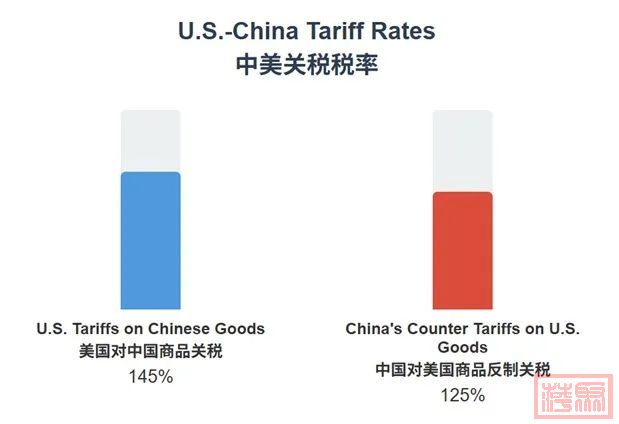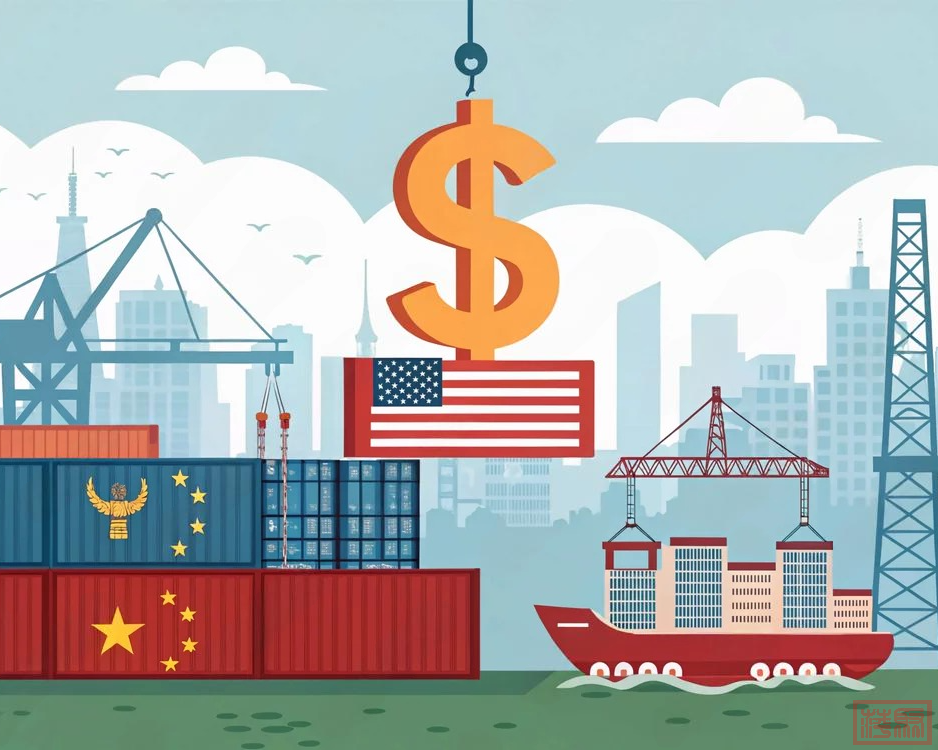|
|
马上注册,结交更多好友,享用更多功能,让你轻松玩转社区。
您需要 登录 才可以下载或查看,没有账号?注册

×
作者:微信文章
中美关税战
The US-China War on Tariffs
01
现状


自今年2月份以来,特朗普政府陆续对美国进口商品加征关税。特朗普将4月2日称为“解放日”,并宣布对其所有贸易伙伴加征“对等关税”。面对特朗普的关税政策,中国快速做出反制,成为了最先反制特朗普关税的国家。4月2日至4月11日期间,中美两国不断将关税推向新高,最终结果如上图所示。除此以外,中国还自4月4日起实施了对7类中重稀土的出口管制。
Since February of this year, the Trump administration has been raising tariffs on U.S. imports. Trump declared April 2 "Liberation Day" and announced reciprocal tariffs on all U.S. trading partners. China responded to Trump’s tariffs swiftly with retaliatory actions and became the first country to push back against Trump’s tariff policy. From April 2 to 11, the two countries raised their tit-for-tat tariffs to new heights as indicated in the above charts. China also imposed export restrictions on 7 medium and heavy rare earth elements (REEs) effective April 4.
02
关税由谁来支付?

关税是国家对进出境货物、物品征收的一种税。加征关税一般有两个目的,一是为了保护本国产品,二是为了增加税收收入。特朗普加征关税的目的是为了促进美国制造业发展。但是,美国制造业面临成本高和供应链短缺等问题,短期内几乎不可能复苏。而且,产品出口偏好的弱美元和低成本,与强美元赋予美国的强购买力,形成天然的矛盾,注定无法共存。所以,特朗普关税带来的直接益处只可能是美国税收收入的增加。那么,这部分关税到底由谁来买单呢?答案是美国民众。因为进口商品的关税一般在商品经过关境时,由进口方支付。美国企业在进口商品时会支付相应的关税,然后通过涨价将关税传导给普通民众,以抵消上涨的成本。简言之,该关税政策将让美国面临更高的物价水平。
A tariff is a tax that a government imposes on goods imported from or exported to other countries. It is a type of trade regulation used to protect domestic products or generate revenue. The purpose of Trump’s tariff policy is to promote U.S. manufacturing. However, high costs and supply chain shortages make the revival of U.S. manufacturing almost impossible in the short term. In addition, a weak dollar makes U.S. exports cheaper and increases demand for American products abroad. On the contrary, a strong dollar allows U.S. consumers to purchase more goods and services from overseas. This natural contradiction makes it hard for the dollar to satisfy both purposes. So, the only direct benefit of Trump’s tariff policy will be the surge in U.S. customs revenue. But who will bear the cost of the tariffs? Well, the answer is the U.S. citizens. The cost of an import tariff is typically paid at the border by the importer, who normally increases the price of imported goods to offset the extra costs. In one word, Trump’s tariff policy will let the U.S. suffer from rising prices.
03
全球经济增长将放缓

目前,全球供应链发展迅速。一种产品可能由来自全球各地的零部件组成,成本也会受多国关税的影响。特朗普此次关税政策的波及范围广、涉及关税高,导致每个国家的关税税率都可能上调或下调。面对频繁变化的关税政策,以及忽高忽低的关税税率,许多企业无法提前规划,只能推迟贸易和投资决策。国际货币基金组织总裁克里斯塔利娜·格奥尔基耶娃说:贸易就像流水,当各国以关税或者非关税壁垒设置障碍时,水流就会改道。一些国家的某些行业可能充斥着过多的进口商品,而其他行业却面临着短缺。国际货币基金组织4月发布的《世界经济展望》报告预测,在贸易紧张局势升级和政策不确定性加剧的背景下,2025年全球经济增速将降至2.8%。
With the rapid development of the global supply chain, a product is now composed of components manufactured by many countries. So, the tariff policies of different countries will impact the cost of such products. The recent Trump tariffs involve many countries and high tariff rates. Each country may react differently by raising or lowering their tariff rates. The unpredictable and changing tariff policies make it difficult for companies to plan in advance. They have to postpone their trade deals and investment decisions. Kristalina Georgieva, Managing Director of IMF, said, "Trade is like water: When countries put up obstacles in the form of tariff and non-tariff barriers, the flow diverts." "Some sectors in some countries may be flooded by cheap imports; others may see shortages. " The IMF World Economic Outlook for April 2025 indicates that global growth is projected to drop to 2.8% in 2025 against the backdrop of escalating trade tensions and policy-induced uncertainty.
04
中国的解决方案
一、降低关税总水平。随着我国改革开放水平的不断提高,我们不再追求贸易顺差,而愿意进口国外的优质产品和服务,促进贸易的平衡发展。目前,中国的关税总水平已经降到7.3%,处于全球较低水平。同时,我们给予所有同中国建交的最不发达国家100%税目产品零关税待遇。二、解决中国电动车在欧洲的困境。2024年10月,欧盟成员国投票通过,在当时10%的税收基础上,对中国产的电动汽车再征收最高35.3%的反补贴税至少五年。然而,欧盟委员会近期与我国达成共识,将设定中国对欧洲出口电动汽车的最低价格,并取代去年开始征收的电动汽车关税。三、中国企业出海。近几年,由于贸易保护政策的增加,许多中国企业和创业者纷纷选择出海建厂。出海企业利用海外劳动力和市场实现发展,并把中国的经营理念和质量标准带到世界各地。中国企业和政府正在以更加开放和智慧的态度来推动世界的进步。
First, lower overall tariff rates. As we reform and open up further, we do not pursue trade surplus anymore. We welcome good import products and services and encourage balanced trade. China’s overall tariff level has reduced to 7.3% now. It is relatively low compared with other countries around the world. Meanwhile, we give all the least developed countries having diplomatic relations with China zero-tariff treatment for 100 percent tariff lines. Second, resolve the difficult situation of Chinese electric vehicles in Europe. In October 2024, the European Commission’s proposal to impose countervailing duties on imports of battery electric vehicles (BEVs) from China obtained the necessary support from EU Member States. Up to 35.3% tariffs were added on top of the existing 10% import duty for Chinese BEVs for at least five years. Recently, the European Commission and China agreed to set the minimum price for Chinese BEVs and remove the tariffs imposed last year. Third, Chinese companies go overseas. In recent years, more Chinese companies and entrepreneurs have started businesses overseas due to the rise of protectionism. These Chinese businesses use local labor and markets to achieve development in other countries. They also bring business philosophies and quality standards from China to the world. The Chinese government and enterprises are promoting the development of the world with openness and intelligence.
词汇 Vocabulary
01
文中所涉及的缩写
REEs (Rare Earth Elements) 稀土元素BEVs (Battery Electric Vehicles) 纯电动汽车IMF (International Monetary Fund) 国际货币基金组织EU (European Union) 欧盟
|
|